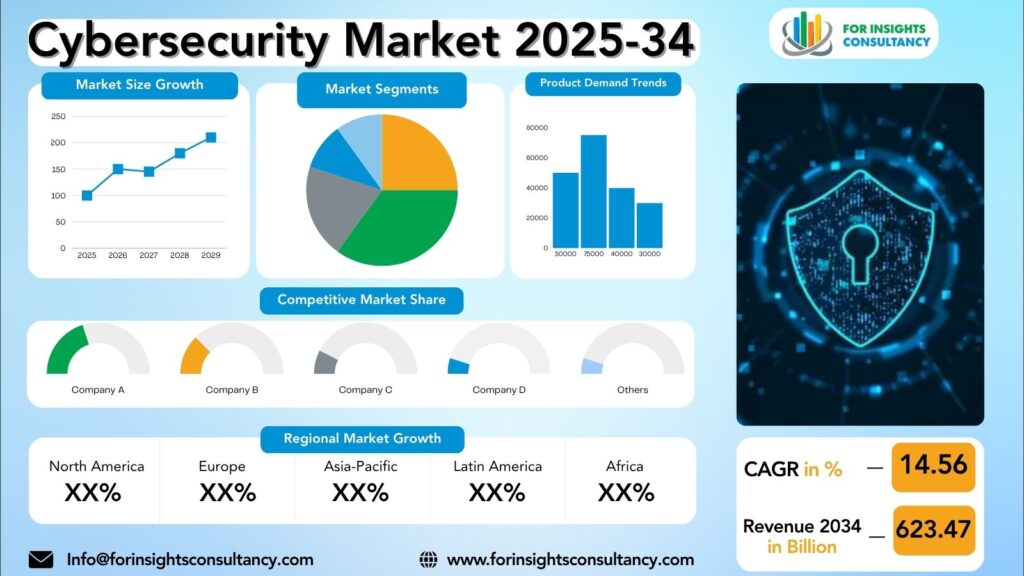
Cybersecurity Market Size, Trends Analysis Research Report By Security Type/Domain (Network Security, Endpoint Security (including Mobile and IoT), Cloud Security, Application Security, Data Security), By Deployment Model, And by Enterprise Size, and By Region Global Market Analysis And Forecast, 2025-2034
Sep-2025 Formats | PDF | Category: IT | Delivery: 24 to 72 Hours
The report highlights that the market outlook is significantly influenced by swift shifts in global trade relations and tariffs. It emphasizes the necessity of updating the report before delivery to incorporate the most current status, which includes revised market forecasts and a comprehensive analysis of the quantified impacts of these changes. Specifically, the Recommendations and Conclusions sections will be enhanced to provide actionable strategies for organizations navigating the rapidly evolving international landscape.
Cybersecurity Market Is Forecast to Increase from USD 219.67 Billion In 2025 To USD 623.47 Billion By 2034, At A CAGR Of 14.56%.
Cybersecurity Market: A Comprehensive Overview and Future Developments
The cybersecurity market is undergoing significant growth and transformation, propelled by the escalating frequency of cyber threats and attacks across the globe. This market encompasses an extensive array of solutions and services designed to defend organizations against risks such as data breaches, malware, ransomware, and various forms of cyber incursions. The acceleration of digital transformation and the adoption of cloud technologies are key drivers that are anticipated to further fuel the demand for cybersecurity solutions in the forthcoming years.
Looking ahead, the cybersecurity sector is expected to concentrate on technological advancements, notably in artificial intelligence (AI) and machine learning (ML), which will enhance capabilities for threat detection and response. Furthermore, there is a growing emphasis on ensuring the security of Internet of Things (IoT) devices and critical infrastructure against cyber threats. As organizations increasingly regard cybersecurity as a crucial area for investment, the market is positioned for ongoing growth and innovation, reflecting the urgent need to address evolving cyber risks.
AI Impact
AI is fundamentally reshaping the cybersecurity landscape by significantly improving threat detection and response mechanisms. As cyber threats become increasingly advanced, solutions powered by artificial intelligence are essential for identifying and mitigating risks in real time. These AI technologies facilitate organizations in predicting and averting potential security breaches, which not only enhances their security posture but also reinforces their defenses against cybercrime. By processing and analyzing extensive datasets, AI algorithms can detect patterns and anomalies that might escape the attention of human analysts, thus proving to be critical assets in the ongoing battle against cyber threats. Consequently, the cybersecurity market is rapidly adapting to integrate AI-driven solutions, addressing the mounting challenges posed to businesses and individuals in the digital domain.
Market Dynamics
Trends
Trends in the cybersecurity market reveal an increasing focus on proactive threat intelligence and response capabilities. The escalation of targeted cyber attacks and data breaches has prompted organizations to allocate resources toward advanced security solutions. Key innovations in this area encompass AI-driven threat detection, the adoption of zero-trust security models, and enhanced cloud security strategies. Furthermore, the rise of remote work, coupled with the proliferation of the Internet of Things (IoT), has amplified the necessity for robust endpoint security and comprehensive network monitoring tools. Additionally, as regulatory frameworks tighten, there is a notable shift towards compliance-driven security solutions, signifying their growing importance in the cybersecurity landscape. In summary, the cybersecurity market is continually evolving to meet the dynamic threats and vulnerabilities it faces, driven by innovative technologies and a proactive stance on security measures.
Growth Drivers
The cybersecurity market is increasingly influenced by a variety of significant growth drivers. A primary factor is the rising frequency and sophistication of cyberattacks that target organizations across various sectors. As businesses continue to digitalize their operations and manage more data, there is an amplified necessity for robust cybersecurity solutions to defend against data breaches and evolving cyber threats. Furthermore, the imposition of stringent regulatory requirements compels organizations to improve their cybersecurity posture, thereby contributing to market expansion. The accelerated adoption of cloud computing, Internet of Things (IoT) devices, and mobile technologies also heightens the demand for cybersecurity solutions designed to protect sensitive information and digital assets. Given the broadening threat landscape and the continuous evolution of cybersecurity challenges, the market is anticipated to experience sustained growth in the forthcoming years.
Restraints
Restraints in the cybersecurity market are multifaceted and primarily stem from several critical factors. Firstly, the constantly evolving nature of cyber threats necessitates that organizations commit to continuous updates and investments in their security solutions, which can be both resource-intensive and challenging to keep up with. This dynamic environment is compounded by a notable shortage of skilled cybersecurity professionals. This skills gap presents significant hurdles for organizations striving to enhance their security measures, as finding and retaining qualified personnel can be difficult.
Moreover, budget constraints often inhibit companies from making the necessary investments in comprehensive cybersecurity solutions, thereby exposing them to heightened vulnerability against potential cyber attacks. The financial limitations faced by many organizations may prevent them from acquiring robust security systems, leaving them at risk.
Additionally, the complexity associated with implementing and managing cybersecurity tools can serve as a deterrent for organizations. Navigating the intricacies of various security systems and integrating them effectively within existing frameworks can overwhelm many entities, leading to inadequate security responses.
In summary, these restraints underline the critical need for strategic planning and resource allocation in the cybersecurity domain. Organizations must develop thoughtful strategies to address these challenges effectively and mitigate potential risks, ensuring that their defenses evolve alongside the threats they face.
Opportunities
The cybersecurity market is currently abundant with growth opportunities due to the escalating number of cyber threats and attacks. Organizations are increasingly in need of robust cybersecurity solutions to safeguard their sensitive data and networks, resulting in a significant demand for cybersecurity products and services. This landscape presents a profitable arena for businesses operating within the industry. Furthermore, as technology progresses, new avenues are arising, particularly in sectors such as cloud security, Internet of Things (IoT) security, and AI-driven cybersecurity solutions. Companies that demonstrate innovation and the ability to adapt to the evolving threat landscape are poised to take advantage of the burgeoning cybersecurity market, potentially positioning themselves as leaders in the field.
Challenges
In the cybersecurity market, organizations encounter a range of significant challenges that impact their ability to secure sensitive data and maintain customer trust. One of the primary issues is the growing sophistication of cyber threats. Cybercriminals are continuously innovating and developing advanced tactics to breach organizational defenses, making it imperative for businesses to adopt proactive measures and stay ahead in the security landscape. Furthermore, the industry is facing a notable shortage of skilled cybersecurity professionals. This scarcity complicates the capacity of organizations to effectively manage and respond to security incidents, thereby increasing vulnerability to data breaches and cyberattacks.
In addition to these challenges, the rapidly changing regulatory environment imposes additional pressures on organizations. Compliance with regulations such as the General Data Protection Regulation (GDPR) and the California Consumer Privacy Act (CCPA) is essential; failure to adhere to these laws can result in severe penalties and reputational damage. Consequently, organizations must invest significantly in advanced technologies and implement robust strategies to navigate this complex terrain. This dynamic nature of the cybersecurity market necessitates continual investment in resources, training, and systems to safeguard against evolving threats, underscoring the critical importance of having a comprehensive cybersecurity framework in place.
Cybersecurity Market Top Companies Covered In This Report:
Evaluate The Strategic Positioning And Innovation Pipelines Of Leading Market Companies-From Multinational Enterprises To Disruptive Regional Firms. Understand How Key Players Are Innovating, Expanding, And Capturing Value, And Use Competitive Benchmarks To Plan Your Next Move.
- Proofpoint, Inc.
- Microsoft Corporation
- Palo Alto Networks, Inc.
- Zscaler, Inc
- Cisco Systems, Inc.
- IBM Corporation
- Fortinet, Inc.
- Broadcom, Inc.
- F5 Networks, Inc.
- Check Point Software Technologies
- NTT Data Group Corporation
- Juniper Networks, Inc.
- Sophos Ltd.
- HCL Technologies
- Huawei Technologies
- EclecticIQ
- CounterCraft
- Tata Consultancy Services
- Sangfor Technologies
Cybersecurity Market Company News 2024 and 2025
Cisco
Faced widespread, state-sponsored attacks exploiting zero-day vulnerabilities in its Adaptive Security Appliances (ASA) firewalls (e.g., CVE-2025-20333, CVE-2025-20362). This resulted in an emergency directive from CISA for federal agencies to take immediate action.
Palo Alto Networks
July 30, 2025 Palo Alto Networks in Talks to Acquire CyberArk for Over $20 Billion
Announced a move to acquire CyberArk (Identity Security) and completed the acquisition of IBM’s QRadar SaaS Assets in late 2024.
HPE
Finalized the Juniper Networks acquisition, with a new focus on an AI for networks and networking for AI dual strategy.
Reported agreement to acquire Wiz (Cloud Security startup).
Segmented View of The Industry:
The Cybersecurity Market Is Mapped Through A Multidimensional Lens-Tracking Shifts Across Product Type, Applications, And Geographic Regions. This Segmented Approach Enables Businesses to Localize Their Growth Plans And Align Offerings With The Most Profitable Demand Centres.
Segmentation By Security Type/Domain
- Network Security
- Endpoint Security (including Mobile and IoT)
- Cloud Security
- Application Security
- Data Security
Segmentation By Offering
- Solutions/Software (e.g., Firewalls, Antivirus/Antimalware, IAM, SIEM)
- Services (e.g., Managed Security Services, Professional Services, Consulting)
Segmentation By Deployment Model
- Cloud-Based
- On-Premises
Segmentation By Enterprise Size
- Large Enterprises
- Small and Medium Enterprises (SMEs)
Segmentation By End-Use Vertical
- BFSI (Banking, Financial Services, and Insurance)
- IT & Telecom
- Government & Defense
- Healthcare
- Retail
- Manufacturing
Global Geographic Coverage:
Based On Recent Market Analysis, North America Is The Largest And Most Mature Market For Very Small Aperture Terminals (Vsat). Its Leading Position Is Driven By Significant Investments In Defense And Government Sectors And A Well-Established Telecommunications Infrastructure.
The Report Provides In-Depth Qualitative And Quantitative Data On The Cybersecurity Market For All Of The Regions And Countries Listed Below:
North America
The North American cybersecurity market stands out as one of the most advanced and competitive regions in the world, with the United States at the forefront, followed by Canada and Mexico. In the US, the market is propelled by a surge in cyber threats and data breaches across various sectors, which compels organizations to allocate significant resources to cybersecurity solutions. The influence of government regulations and the establishment of cybersecurity frameworks further shape the landscape of this market.
In Canada, growth is driven by an increasing shift towards cloud-based services and a spike in cyber attacks targeting government entities and critical infrastructure. The Canadian government emphasizes improving its cybersecurity defenses through partnerships with the private sector and investments in cutting-edge technologies, thereby enhancing its overall cybersecurity posture.
Meanwhile, Mexico is experiencing substantial growth within its cybersecurity sector, attributed to the rising digitalization of businesses and the escalation of cybercrime activities. The government’s initiatives aimed at bolstering cybersecurity capabilities and expanding threat intelligence are key factors contributing to this growth.
In conclusion, North America continues to serve as a vital hub for cybersecurity innovation and investment, marked by ongoing advancements in technology to address the challenges posed by evolving cyber threats.
Europe
Cybersecurity has emerged as a crucial element in the contemporary digital landscape, particularly in Europe, where the surge in cyber threats and data breaches has prompted a heightened focus on cybersecurity measures. Various European nations, inclusive of the United Kingdom, Germany, and France, have notably ramped up investments and initiatives in the cybersecurity sector to safeguard vital infrastructure and sensitive data.
The United Kingdom stands out for its vigorous approach towards cybersecurity regulation and compliance, establishing comprehensive cybersecurity frameworks aimed at mitigating potential cyber risks. Germany is recognized for its sophisticated cybersecurity technologies and specialization, especially concerning industrial cybersecurity, which is pivotal given the country’s extensive industrial base.
In France, there is a concerted effort to foster cybersecurity innovation through enhanced collaboration between public and private sectors. This strategy aims to improve the nation’s cyber resilience and adapt to the continuously changing threat landscape. Additionally, countries such as Spain, Italy, and the Netherlands are also escalating their cybersecurity capabilities to better tackle emerging cyber threats.
In summary, the European cybersecurity market is in a constant state of evolution, characterized by ongoing investments in advanced technologies and best practices, all designed to protect essential assets and data against the backdrop of an increasingly complex cyber threat environment.
Asia Pacific
The Asia Pacific region is becoming increasingly significant in the cybersecurity market, marked by strong growth and the adoption of various cybersecurity measures across multiple countries. China has experienced a notable increase in cybersecurity expenditures, largely prompted by a rise in cyber threats aimed at both government and private sectors. To counter these threats, the Chinese government has actively pursued the implementation of stringent cybersecurity regulations aimed at protecting sensitive data and critical infrastructure.
Japan’s focus has also intensified on enhancing its cybersecurity capabilities, particularly following the challenges presented by the 2020 Tokyo Olympics. The Japanese government has made substantial investments aimed at strengthening cybersecurity infrastructure and devising a comprehensive cybersecurity framework to secure its digital assets against emerging threats.
South Korea too is playing a pivotal role in the cybersecurity landscape, with government initiatives aimed at reinforcing the country’s cybersecurity posture and reducing cyber risks. South Korea has been channeling funds into cybersecurity technologies and forging partnerships with industries to boost its resilience against cyber incidents.
In conclusion, the Asia Pacific region holds considerable potential for growth in the cybersecurity sector, with China, Japan, and South Korea at the forefront of implementing robust measures to enhance their cybersecurity defenses and protect against cyber threats.
Middle East and Africa
The cybersecurity market in the Middle East and Africa (MEA) is experiencing rapid growth driven by the increasing necessity for digital transformation and escalating cyber threats. Within the Middle East, prominent nations such as Saudi Arabia, the United Arab Emirates (UAE), and Israel are taking the lead in making substantial investments in cybersecurity to safeguard critical infrastructures and sensitive data. Saudi Arabia is enhancing cybersecurity regulations and investing in advanced technologies to counteract cyber threats effectively. The UAE prioritizes cybersecurity as part of its broader digital transformation initiatives, emphasizing the protection of government networks and essential sectors. Israel, renowned for its cybersecurity expertise, continues to innovate and provide cutting-edge solutions aimed at addressing the dynamic nature of cyber threats.
In Africa, countries including South Africa, Kenya, and Nigeria are intensifying their cybersecurity measures to combat cybercrime and protect digital assets. South Africa has put in place comprehensive cybersecurity frameworks and established partnerships to bolster its cyber resilience. Kenya is focusing on cybersecurity awareness campaigns and capacity-building efforts to counter the increasing cyber threats faced by its digital landscape. Nigeria is dedicated to enhancing its cybersecurity infrastructure and fostering collaboration to safeguard its digital economy. Collectively, both the Middle East and Africa are witnessing significant advancements and innovations in the cybersecurity sector, as nations strive to secure their digital ecosystems against an ever-evolving threat landscape.
Reasons To Buy:
- The Research Would Help Top Administration/Policymakers/Professionals/Product Advancements/Sales Managers And Stakeholders In This Market In The Following Ways.
- The Report Provides Cybersecurity Market Revenues At The Worldwide, Regional, And Country Levels With A Complete Analysis To 2034 Permitting Companies To Analyze Their Market Share And Analyze Projections, And Find New Markets To Aim For.
- To Understand The Most Affecting Driving And Restraining Forces In The Market And Their Impact On The Global Market.
- Major Changes And Assessment In Market Dynamics And Developments.
- The Objective Of The Cybersecurity Market Report Is To Identify New Business Opportunities Using Quantitative Market Forecasts.
- Formulate Sales And Marketing Strategies By Gaining An Understanding Of Competitors, Their Positioning, And Strengths & Weaknesses.
Faq – What Global Leaders Are Asking
What Is The Growth Prospect For The Cybersecurity Market By 2034?
Cybersecurity Market Is Expected To Achieve A Stable Growth Rate With A Compound Annual Growth Rate (CAGR) Of About 14.56% From 2025 Through 2034.
What Is Driving The Growth Of The Cybersecurity Market?
The growth is primarily driven by the growing frequency and sophistication of cyber threats like AI-augmented ransomware, which forces businesses to increase defensive spending.
This escalating threat landscape is compounded by accelerated digital transformation (cloud migration, remote work) and stringent global regulatory compliance.
Who Are The Key Players In The Cybersecurity Market, And What Are Their Market Shares?
The Cybersecurity Market Includes Major Companies Like Proofpoint, Inc., Microsoft Corporation, Palo Alto Networks, Inc., Zscaler, Inc, Cisco Systems, Inc., IBM Corporation, Fortinet, Inc., Broadcom, Inc., F5 Networks, Inc., Check Point Software Technologies, NTT Data Group Corporation, Juniper Networks, Inc., Sophos Ltd., HCL Technologies, Huawei Technologies, EclecticIQ, CounterCraft, Tata Consultancy Services, Sangfor Technologies, Others.
Specific Market Share Data Is Not Publicly Available And Is Typically Provided In Detailed, Proprietary Market Research Reports.
Which Regions Are Leading The Cybersecurity Market Growth?
North America holds the largest market share, driven by a mature digital ecosystem, high rates of cyberattacks, and the presence of major security firms.Asia-Pacific is the fastest-growing region, fueled by rapid digital transformation, increasing internet adoption, and government cybersecurity initiatives..
Customization: We Can Provide Following Things
1) On Market More Company Profiles (Competitors)
2) Data About Particular Country Or Region
3) We Will Incorporate The Same With No Additional Cost (Post Conducting Feasibility).
Any Requirement Contact Us: Https://Www.Forinsightsconsultancy.Com/Contact-Us/
Table of Contents
For TOC Contact us: https://forinsightsconsultancy.com/contact-us/






